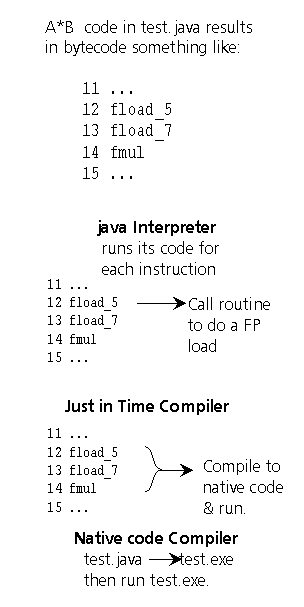
| Home : Course Map : Chapter 1 : Java : Supplements : |
|
Advanced Virtual Machines
|
| JavaTech |
| Course Map |
| Chapter 1 |
| Introduction History What is Java? Versions Java 5.0 Features Java Process Tools Documentation Compatibility Getting Started Simple Applet Simple Application Starters Exercises |
|
Supplements |
| About
JavaTech Codes List Exercises Feedback References Resources Tips Topic Index Course Guide What's New |
|
The interpretation approach to program execution provides for transportable code but usually at the cost of slower execution. Advances in Java Virtual Machine (JVM) design, however, have greatly enhanced Java performance and Java programs can now reach speeds approaching that of C/C++ for many applications. The figure below illustrates the essential steps in running a Java program. First is shown the bytecode for a multiplication of two floating point numbers.
The most basic VM would simply interpret each line of the bytecode sequentially. (Of course, it will occasionally jump to a different section of code when it executes a jump command.) If written in C, it might use a long switch statement with a case for each possible bytecode instruction. Alternatively, a JVM that includes a Just-In-Time (JIT) compiler will instead convert the instructions to native machine language the first time it encounters these instructions. That is, it compiles on the fly or just-in-time to execute the instructions.
In the first pass this compilation will slow the program somewhat. However, for code sections that run repetitively, such as a loop in a math computation, the native code executes on the subsequent passes and thus provides the full performance capabilities of the platform. Sun's Hotspot JVM takes an even more sophisticated approach. It dynamically monitors, or profiles, a program's performance as it is running and looks for sections of the code where execution slows significantly. When it finds such a section, it will optimize that code and compile it to native machine language for faster execution. In such cases, the optimization may result in speeds that actually exceed those for C programs. A crude but effective approach, at least as far as speed is concerned, is to compile the bytecode directly to local machine code. So-called native code compilers and ahead-of -time compilers will provide very fast performance but, of course, at the price of eliminating the platform independence of the code and preventing dynamic binding.
References & Web Resources
Latest update: Oct. 5.05 |
|
Tech |
|
Physics |
